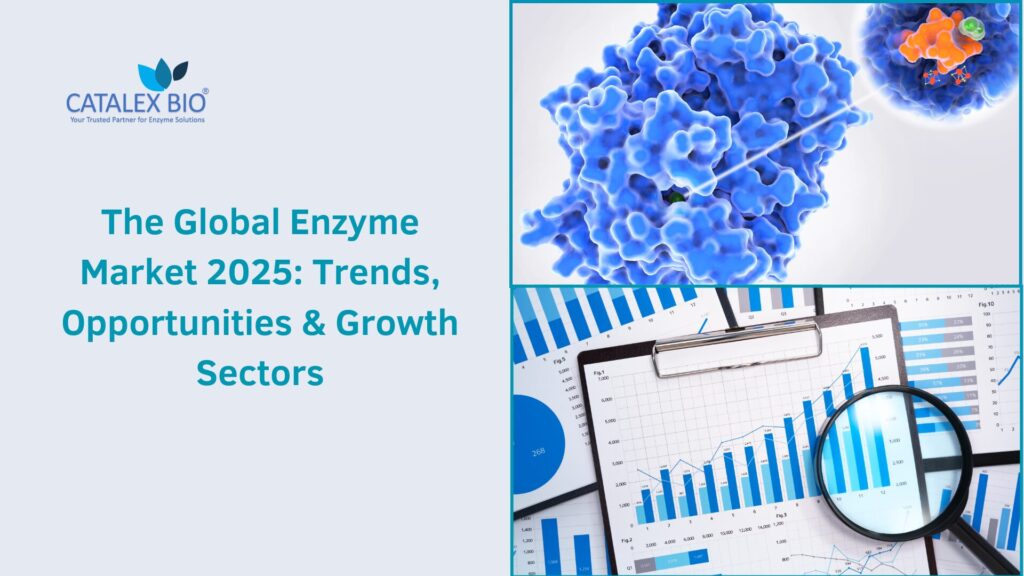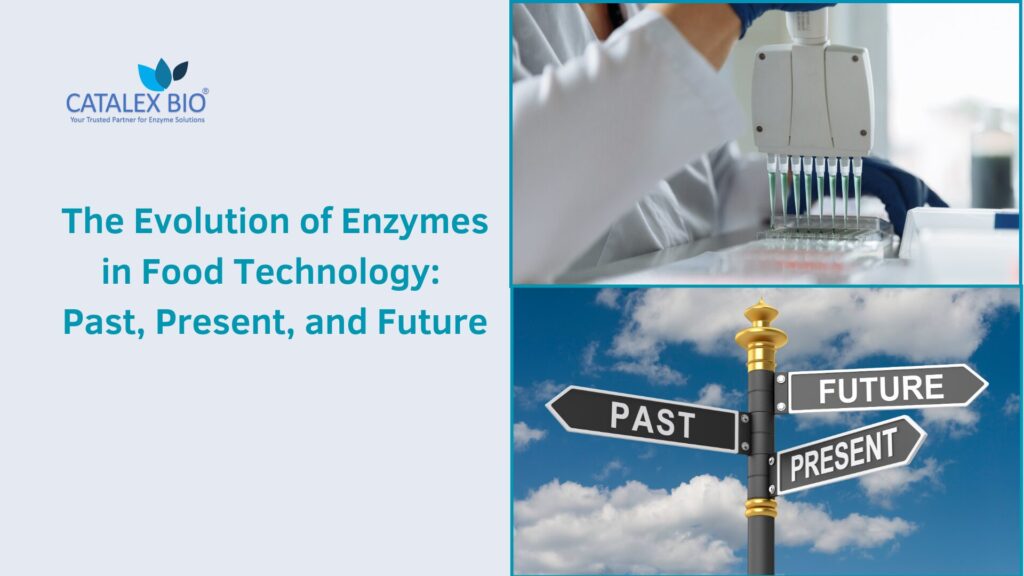Enzymes have become essential tools across industries — from food, beverages, and dairy to textiles, detergents, paper, biofuels, and nutraceuticals. Yet, enzyme communication is filled with technical language that can make purchasing, comparing specifications, or negotiating prices confusing.
This Comprehensive Enzyme Buyer’s Glossary by Catalex Bio simplifies that complexity. It explains important enzyme terminology with plain-language definitions and practical buyer insights — empowering you to make informed, technical, and strategic decisions.
1. Core Enzyme Science Terms
Enzyme
A biological catalyst, typically a protein, that accelerates biochemical reactions without being consumed.
Buyer Insight: Understanding enzyme activity helps buyers evaluate performance and cost-effectiveness in real applications.
Catalyst / Biocatalyst
Any molecule that speeds up a chemical reaction; a biocatalyst refers to natural catalysts like enzymes or whole microbes.
Buyer Insight: Every enzyme is a biocatalyst, but not every biocatalyst is an enzyme — a distinction relevant in product labeling and regulatory claims.
Substrate
The molecule an enzyme acts upon (e.g., starch for amylases).
Buyer Insight: Matching enzyme to substrate ensures maximum conversion efficiency.
Active Site
The region of an enzyme where the substrate binds and the reaction occurs.
Buyer Insight: Variations in active-site structure influence selectivity, potency, and dosage optimization.
Enzyme–Substrate Complex
A temporary association formed when substrate binds to enzyme.
Buyer Insight: Reaction speed depends on how efficiently this complex forms and breaks apart.
Product
The molecule produced after enzymatic conversion.
Buyer Insight: Observing product quality (clarity, sweetness, viscosity, texture) can reveal real-world enzyme performance.
Cofactor / Coenzyme
Helper molecules required for catalytic activity. Cofactors are inorganic (Ca²⁺, Mg²⁺); coenzymes are organic (vitamins, NAD⁺).
Buyer Insight: Missing cofactors reduce activity — verify whether your formulation already contains them.
Enzyme Specificity
The selectivity of an enzyme for its substrate or reaction.
Buyer Insight: High specificity minimizes off-reactions, critical for clean-label products.
Isoenzymes / Isozymes
Different molecular forms that catalyze the same reaction under different conditions.
Buyer Insight: Selecting the right isoenzyme allows process optimization for varying pH or temperature.
Enzyme Kinetics
The study of reaction rates and efficiency (parameters such as Km and Vmax).
Buyer Insight: Kinetic data help understand performance of enzymes
2. Enzyme Sources and Origins
Microbial Enzymes
Produced by bacteria, yeasts, or fungi — the backbone of industrial enzyme manufacturing.
Buyer Insight: Offer scalability, consistency, and regulatory traceability.
Fungal Enzymes
From fungi such as Aspergillus niger or Trichoderma reesei.
Buyer Insight: Known for broad pH tolerance and stable secretion systems.
Bacterial Enzymes
Typically from Bacillus species, valued for thermostability.
Buyer Insight: Ideal for starch, detergent, and feed applications requiring heat tolerance.
Yeast Enzymes
Produced by yeast strains for brewing, ethanol, and flavor generation.
Buyer Insight: Often contribute mild sensory profiles desirable in beverages.
Plant Enzymes
Extracted from natural sources such as papaya (papain) or pineapple (bromelain).
Buyer Insight: Favoured in nutraceuticals and natural-label formulations.
Animal Enzymes
Derived from digestive organs (pepsin, rennet, pancreatin).
Buyer Insight: Gradually replaced by microbial analogs but still used in certain traditional or pharmaceutical processes.
Genetically Modified (GM) Enzymes
Produced via engineered microorganisms for improved yield and stability.
Buyer Insight: Provide consistent quality and cost efficiency; verify export-market GMO regulations.
Non-GMO Enzymes
Sourced from non-modified strains.
Buyer Insight: Mandatory for organic and clean-label certification.
Recombinant Enzymes
Generated through recombinant DNA technology.
Buyer Insight: Allow precise control of properties like pH optimum or substrate affinity.
3. Enzyme Production and Processing
Fermentation
Controlled microbial cultivation to produce enzyme biomass.
Buyer Insight: Fermentation efficiency affects enzyme cost and purity.
Submerged Fermentation (SmF)
Microorganisms grow in nutrient liquids.
Buyer Insight: Standard for bacterial enzymes; offers reproducible yields.
Solid-State Fermentation (SSF)
Microbes grow on moist solids such as bran.
Buyer Insight: Favoured for fungal enzymes; delivers high concentration and lower waste.
Downstream Processing
Separation, purification, and formulation steps post-fermentation.
Buyer Insight: Determines purity level, stability, and price point.
Purification / Crude Extracts
Removal of unwanted biomass and metabolites.
Buyer Insight: Choose grade according to application — crude for detergents, purified for food.
Concentration / Standardization
Adjusting enzyme activity to a defined strength.
Buyer Insight: Guarantees consistent performance from batch to batch.
Immobilization
Binding enzymes to solid supports for reuse and stability.
Buyer Insight: Used in continuous processes such as lactose-free milk or biodiesel production.
Cell Disruption
Mechanical or chemical rupture of cells to release intracellular enzymes.
Buyer Insight: Impacts yield and impurity profile.
Lyophilization / Spray Drying
Methods for drying liquid enzymes into powders.
Buyer Insight: Affects shelf life and re-solubility.
Formulation Engineering
Balancing carriers, stabilizers, and preservatives.
Buyer Insight: Determines flow properties, activity retention, and compatibility with your process medium.
4. Enzyme Testing and Activity Measurement
Enzyme Activity (U / IU)
Amount of substrate converted per minute under defined conditions.
Buyer Insight: Always compare activity units, not price per kg.
Specific Activity (U/mg)
Activity normalized to protein content.
Buyer Insight: Higher values indicate greater purity and efficiency.
Assay
Standardized test to quantify enzyme performance.
Buyer Insight: Confirm the assay method used — e.g., DNS, casein, or PNPG assays.
Km and Vmax
Kinetic constants measuring substrate affinity and maximum rate.
Buyer Insight: Lower Km = higher efficiency at low substrate levels.
Activity Loss / Recovery
Change in strength over storage or processing.
Buyer Insight: Examine supplier stability data under your storage conditions.
Industry Units
Specialized measures:
- FPU (Filter Paper Units) – cellulase
- HUT – protease
- DU – amylase
- LU – lipase
- PU – pullulanase
Buyer Insight: Align unit systems before comparing supplier quotes.
5. Enzyme Functional Performance
Optimum pH / Optimum Temperature
Conditions yielding maximum efficiency.
Buyer Insight: Verify that both align with your process environment.
Thermostability and pH Stability
Resistance to inactivation across temperature or pH ranges.
Buyer Insight: Stable enzymes simplify process control and logistics.
Half-Life
Time required for activity to drop 50 %.
Buyer Insight: Direct indicator of durability during processing or storage.
Denaturation
Irreversible loss of enzyme structure and function.
Buyer Insight: Recognizing denaturation points prevents yield losses.
Synergistic Action
Enhanced effect from enzyme combinations (e.g., xylanase + cellulase).
Buyer Insight: Multi-enzyme blends often lower total dosage and cost-in-use.
Reaction Rate / Yield
Speed of conversion and overall output.
Buyer Insight: Crucial metric for ROI and process optimization.
Inhibition
Reduction of activity due to by-products or contaminants.
Buyer Insight: Select formulations resistant to inhibitors like heavy metals or surfactants.
Activation Energy
Minimum energy required for a reaction.
Buyer Insight: Lower activation energy correlates with faster reaction and lower processing time.
Process Robustness
Ability of an enzyme to tolerate variations in raw materials or environment.
Buyer Insight: Choose robust enzymes for variable feedstocks or seasonal operations.
6. Formulation and Physical Properties
Liquid Enzymes
Aqueous preparations.
Buyer Insight: Enable precise metering but need stabilizers for shelf life.
Powder / Granular Enzymes
Dehydrated, free-flowing forms.
Buyer Insight: Easier storage and export; manage dust with PPE.
Encapsulated / Coated Enzymes
Protective layering to prevent premature activation.
Buyer Insight: Essential for feed and detergent pellets.
Carrier
Inert base supporting enzyme dispersion (maltodextrin, salt, silica).
Buyer Insight: Must be food-grade and compatible with downstream processes.
Stabilizer / Preservative
Compounds that enhance shelf life.
Buyer Insight: Glycerol, sorbitol, or calcium salts are common; review for label compliance.
Mesh Size / Bulk Density / Moisture Content
Indicators of physical handling properties.
Buyer Insight: Uniform mesh ensures dosing accuracy; low moisture improves stability.
Solubility / Dispersibility
Ease of dissolving enzyme powder.
Buyer Insight: Impacts mixing uniformity and reaction kinetics.
Working Concentration
Functional enzyme level in process.
Buyer Insight: Determine empirically through pilot studies.
Compatibility
Ability to coexist with process chemicals (surfactants, oxidants, acids).
Buyer Insight: Verify for detergents, beverages, or biofuel formulations.
7. Quality, Certification & Documentation
Food Grade / Feed Grade / Technical Grade
Defines purity and safety level.
Buyer Insight: Match grade to end-use to ensure regulatory compliance.
GRAS / GMP / HACCP / ISO 22000
Quality-system certifications.
Buyer Insight: Signal reliable manufacturing and international acceptance.
COA (Certificate of Analysis)
Batch-specific results on activity, pH, appearance, microbial limits.
Buyer Insight: Essential for QA release and traceability.
TDS (Technical Data Sheet)
Specification and application guide.
Buyer Insight: Review alongside COA for a complete performance picture.
MSDS / SDS
Safety documentation covering hazards and PPE.
Buyer Insight: Mandatory for transport and worker training.
USP / FCC Compliance
Indicates conformity with pharmacopeial or food additive standards.
Buyer Insight: Critical for nutraceutical or export markets.
Halal / Kosher / Allergen-Free
Cultural and dietary certifications.
Buyer Insight: Expand product acceptance across diverse consumer bases.
Non-Allergenic Declaration / Vegan Status
Confirms absence of animal-derived materials.
Buyer Insight: Important for plant-based or cruelty-free positioning.
Zero-Contamination Policy / Retention Samples
Quality systems for traceability.
Buyer Insight: Retained reference samples safeguard buyer audits and dispute resolution.
Lot Number / Batch Traceability
Unique production identifiers.
Buyer Insight: Ensure full backward tracking to raw-material source.
Regulatory Dossier / Safety Assessment
Comprehensive data package for local registration.
Buyer Insight: Accelerates product approvals and import clearance.
8. Commercial and Operational Terms
Dosage
Enzyme quantity applied per unit substrate.
Buyer Insight: Optimize for efficacy, not just minimal cost.
Cost-in-Use
True economic value: enzyme cost relative to product yield.
Buyer Insight: Lower cost-in-use often beats cheaper unit prices.
MOQ (Minimum Order Quantity)
Supplier’s minimum saleable volume.
Buyer Insight: Catalex Bio supports pilot-scale orders (5–10 kg) for trials.
Pilot-Scale / Trial Runs
Small production tests validating enzyme performance.
Buyer Insight: Prevent large-scale formulation errors.
Process Window
Acceptable range of temperature, pH, and time.
Buyer Insight: Ensures operational flexibility and stable yields.
Storage Conditions / Shelf Life
Recommended storage and guaranteed potency period.
Buyer Insight: Follow specified temperature (<25 °C) and humidity controls for full 12–24 month shelf life.
Lead Time
Time from order confirmation to delivery.
Buyer Insight: Consider fermentation and QC timelines (often 2–6 weeks).
Packaging Integrity
Protection against moisture, oxygen, and contamination.
Buyer Insight: Multi-layer packaging extends shelf stability during global transit.
Technical Support / Application Support
Supplier guidance for optimization and troubleshooting.
Buyer Insight: Choose partners offering data-driven, collaborative support — not just product supply.
Conclusion — Speak the Language of Enzymes, Buy Smarter
Understanding enzyme terminology goes beyond technical literacy — it’s a strategic capability that drives better decisions, cost optimization, and regulatory compliance.
By mastering these key terms, you can:
✅ Evaluate enzymes beyond marketing claims
✅ Communicate effectively with R&D and suppliers
✅ Ensure compliance across domestic and export markets
✅ Optimize formulations for efficiency and sustainability
At Catalex Bio, we believe informed buyers build stronger, more resilient value chains. Our mission is to simplify enzyme selection through scientific clarity and proactive technical support.
Whether you require amylase for baking, protease for nutraceuticals, or xylanase for pulp and paper, Catalex Bio helps you make confident, data-driven decisions.
👉 Explore our enzyme portfolio: https://catalexbio.com/products-solutions/
Catalex Bio — Empowering smarter enzyme decisions through science, support, and sustainability.



